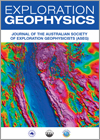
Exploration Geophysics
Volume 49 Number 3 2018
EG16046Noise reduction of grounded electrical source airborne transient electromagnetic data using an exponential fitting-adaptive Kalman filter
GREATEM field data usually includes a mixed variety of noises, which makes the exponential decaying signal too difficult to identify. This paper presents an exponential fitting-adaptive Kalman filter (EF-AKF) to remove mixed electromagnetic noises, while preserving the signal characteristics. As a new method, the EF-AKF can be used for denoising exponential decaying signals.
EG16067Three-dimensional inversion of CSAMT data in the presence of topography
In this paper, we present a scheme to incorporate 3D controlled-source audio frequency magnetotelluric (CSAMT) topographic distortions into the 3D inversion instead of correcting them. This approach has been verified by comparison with 2D FEM CSAMT solutions and synthetic inversion examples. The field example also illustrates the effectiveness of our approach.
EG16079Three-dimensional tensor controlled-source audio-frequency magnetotelluric inversion using LBFGS
We have shown in this paper that directly using a magnetotelluric method to invert the data of the tensor controlled-source audio-frequency magnetotelluric (CSAMT) will obtain an incorrect result, the inversion result of tensor CSAMT is more reliable than that of the traditional CSAMT, and the limited-memory Broyden-Fletcher-Goldfarb-Shanno (LBFGS) method is more efficient than the nonlinear conjugate gradient (NLCG) method for tensor CSAMT.
EG16038Mapping electrical structures in the southern Great Khingan Range, north-east China, through two-dimensional magnetotelluric sounding
Magnetotelluric measurements were carried out in the southern Great Khingan Range, Inner Mongolia, China, from 2012 to 2014. After 2D inversion, the Paleozoic Hunnitu and Gadasu depressions were discovered and inferred to possibly contain Linxi strata. The Mesozoic Xiretu depression was also discovered, which possibly contains Cretaceous hydrocarbon-bearing strata.
EG17054Estimating high hydraulic conductivity locations through a 3D simulation of water flow in soil and a resistivity survey
We propose a simple method for estimating high hydraulic conductivity locations. The proposed method uses the 3D simulations of soil water flow and resistivity survey during a groundwater recharge experiment. Results of numerical and field experiments indicate that the proposed method estimates the high hydraulic conductivity locations more precisely compared with 3D inversion of in-line data.
EG17029A novel approach to comparing AEM inversion results with borehole conductivity logs
Two consistent methods of comparing borehole induction logs with models from inversion of AEM data have been developed: one in model space and one in data space. The two methods are applied to the Broken Hill Managed Aquifer Recharge project conducted by Geoscience Australia on AEM data from the SkyTEM system.
EG16100Regularisation parameter adaptive selection and its application in the prestack AVO inversion
In this paper, based on L-curve criterion, we propose an improved method for the adaptive acquisition of regularisation parameters for arbitrary norm condition. A detailed derivation of the proposed method is described. Numerical experiments confirm that the proposed method is more accurate and robust than its main competitor, generalised cross-validation.
EG17017A robust surface-consistent residual phase correction method based on migrated gathers
We present a novel approach for surface-consistent residual phase corrections based on migrated gathers to improve the SNR and resolution of migrated images. This method includes the following new aspects: the residual statics and phase are estimated by dual parameter cross-correlation, and determined after migration.
EG160583D seismic attributes for structural mapping and enhancement of deep gold mining: a case study from the West Wits Line goldfields, South Africa
In this study, we use sophisticated seismic attributes to interpret the 3D reflection seismic data to: (1) assess and mitigate the risks posed by deep mining activities and (2) improve the resource evaluation of the gold-bearing quartz pebble conglomerate horizons (reefs) in the world’s deepest gold mines (South Africa).
EG16097Azimuthal seismic responses from shale formation based on anisotropic rock physics and reflectivity method: a case study from south-west China
We have constructed an anisotropic rock physics model at the seismic scale for shales, and applied it to the Longmaxi Shale in the Sichuan Basin, south-west China. The simplified reflectivity method is proposed to calculate seismic responses for amplitude variation with offset and azimuth (AVAz) analysis.
EG16048Study of Scholte wave dispersion curves and modal energy distribution using a wavefield numerical simulation method
In this paper, we examine the characteristics of Scholte wave dispersion curves and their modal energy distribution by combining analytical solutions of the dispersion equation with numerical modelling. The modelling results showed that our approach can facilitate Scholte wave exploration in water-covered areas.
EG16144Acoustic wave propagation simulation by reduced order modelling
A reduced order modelling method is introduced for wave propagation modelling by using the mode shapes of the model. The numerical accuracy, computational performance and boundary conditions of the proposed method were investigated. According to the results, the proposed method substantially improves the computational efficiency of the reverse time migration.
EG16115Regional and residual gravity anomaly separation using the singular spectrum analysis-based low pass filtering: a case study from Nagpur, Maharashtra, India
We present a singular spectrum analysis (SSA)-based algorithm for regional and residual gravity anomaly separation. Initially, we tested the method on synthetic data and applied gravity profiles from the Umred coalfield, Nagpur, Maharashtra, India. Final 2D crustal models obtained from the filtered regional anomaly agree well with regional geology and borehole information.
EG16072Enhancement of fault interpretation using multi-attribute analysis and artificial neural network (ANN) approach: a case study from Taranaki Basin, New Zealand
This paper describes an improved and efficient workflow that refines the art of structural interpretation from 3D seismic data. The research aims to streamline the interpretation workflow using better data conditioning scheme and defining a meta-attribute (fault probability cube) using an artificial neural network. A robust pathway is provided for delineating structural details of complex geological terrain.

